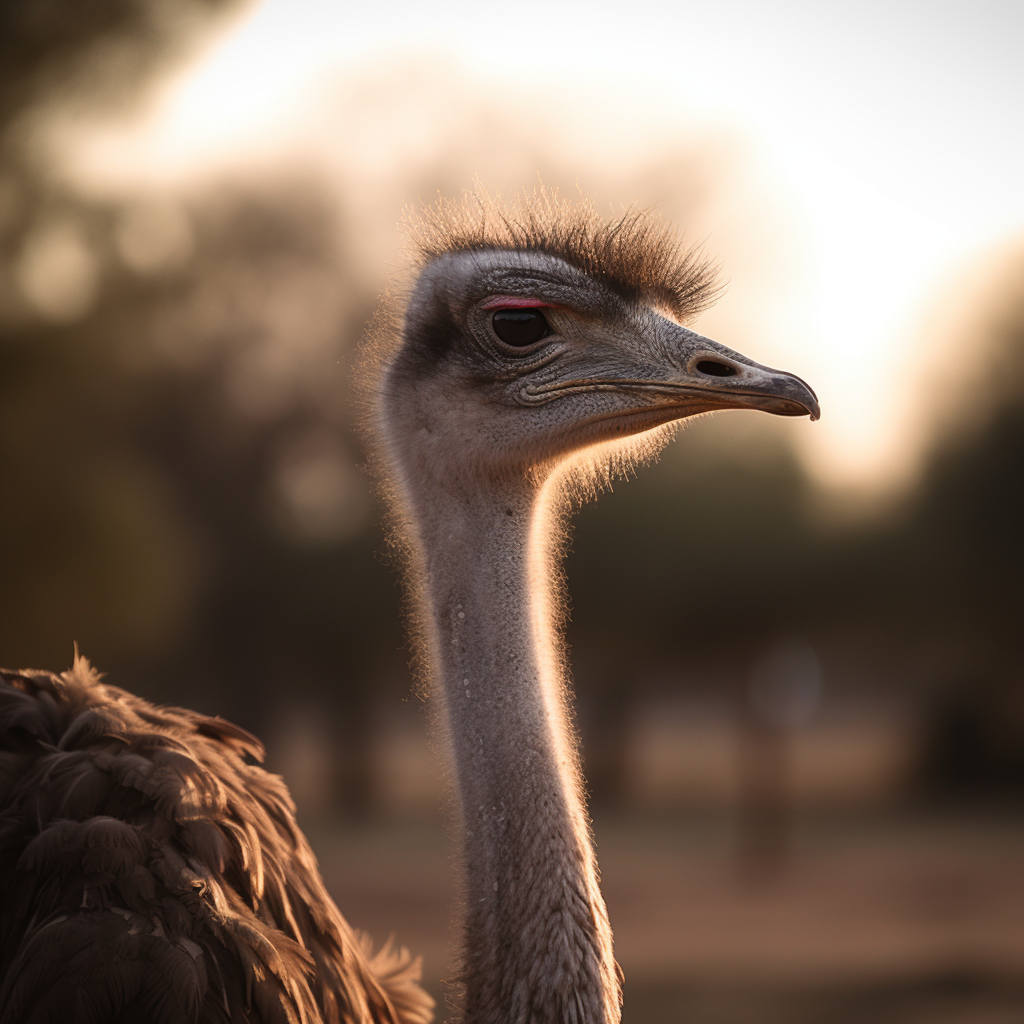The speed and agility of animals have always fascinated us. When it comes to the fastest land animals, the cheetah is often the first to come to mind. Known for its incredible speed and acceleration, the cheetah can reach speeds of up to 70 miles per hour (113 kilometers per hour) in just a few seconds. However, there is another animal that can give the cheetah a run for its money – the ostrich. With its long legs and powerful strides, the ostrich is the largest bird in the world and is capable of running at impressive speeds. In this article, we will explore the question: is an ostrich faster than a cheetah? Let’s dive in and find out.
Key Takeaways
- The cheetah is the fastest land animal, capable of reaching speeds up to 70 mph.
- The ostrich is the fastest bird, capable of running at speeds up to 60 mph.
- While the cheetah is faster than the ostrich, both are incredibly swift creatures in their respective domains.
Understanding the Cheetah: The Speed King
A. The Cheetah’s Physical Attributes for Speed
When it comes to speed, the cheetah is undoubtedly the king of the animal kingdom. This magnificent creature is built for speed, with a sleek and aerodynamic body that allows it to reach incredible velocities. Let’s take a closer look at the physical attributes that make the cheetah such a formidable sprinter.
-
Muscular Build: The cheetah’s body is designed for speed. It has long, slender limbs and a flexible spine that work together to maximize stride length and minimize energy expenditure. This allows the cheetah to cover more ground with each stride, propelling it forward at astonishing speeds.
-
Lightweight Frame: Unlike other big cats, the cheetah is relatively lightweight. This is due to its smaller size and reduced muscle mass. By being lighter, the cheetah can accelerate more quickly and maintain its top speed for longer periods.
-
Large Nasal Passages: The cheetah’s respiratory system is highly efficient, enabling it to take in large amounts of oxygen during a sprint. Its nasal passages are wide, allowing for rapid inhalation and exhalation. This increased oxygen intake helps fuel the cheetah’s muscles and maintain its speed.
-
Flexible Spine: The cheetah’s spine is incredibly flexible, acting like a coiled spring. This flexibility allows the cheetah to stretch its body to its maximum potential during each stride, generating more power and speed.
-
Long Tail: The cheetah’s long, muscular tail serves as a rudder, providing balance and stability during high-speed chases. It acts as a counterbalance, allowing the cheetah to make sharp turns and sudden changes in direction without losing momentum.
B. The Cheetah’s Hunting Strategy: A Display of Speed
The cheetah’s incredible speed is not just a physical attribute; it is also a vital component of its hunting strategy. As an apex predator, the cheetah relies on its speed to catch its prey. Here’s a glimpse into the cheetah’s hunting tactics:
-
Stalking: Before launching into a high-speed chase, the cheetah first stalks its prey. It carefully approaches its target, using its exceptional camouflage to blend into the surroundings. The cheetah’s spotted coat helps it blend in with the grass and bushes of the African savannah, allowing it to get closer to its prey undetected.
-
Sudden Burst of Speed: Once the cheetah is within striking distance, it unleashes its incredible speed. In a matter of seconds, it can accelerate from 0 to 60 miles per hour (0 to 97 kilometers per hour). This acceleration is faster than most sports cars!
-
Chasing Down the Prey: The cheetah’s chase is a breathtaking display of agility and speed. It uses its long strides and powerful leg muscles to rapidly close the gap between itself and its prey. The cheetah’s flexible spine and muscular tail aid in maintaining balance and making quick turns during the pursuit.
-
Short-Lived Sprints: Despite its remarkable speed, the cheetah can only maintain its top speed for short distances. After a sprint of about 20 to 30 seconds, the cheetah’s body temperature rises to a point where it needs to rest and recover. This makes each hunt a high-stakes race against time for the cheetah.
In conclusion, the cheetah’s physical attributes and hunting strategy make it the undisputed speed king of the animal kingdom. Its sleek body, lightweight frame, and flexible spine allow it to reach incredible speeds, while its stalking and chasing techniques ensure a successful hunt. The cheetah truly embodies the saying “speed kills” in the wild.
The Ostrich: A Speedy Surprise in the Bird Kingdom

The ostrich is a fascinating bird known for its incredible speed and unique physical adaptations. In this section, we will explore the ostrich’s physical adaptations for speed and how its speed serves as a survival mechanism in the animal kingdom.
A. The Ostrich’s Physical Adaptations for Speed
The ostrich is the largest bird in the world, standing tall at around 9 feet and weighing up to 320 pounds. Despite its large size, the ostrich has evolved several physical adaptations that enable it to reach impressive speeds.
-
Long Legs: One of the ostrich’s key adaptations for speed is its long, powerful legs. These legs allow the ostrich to take long strides and cover a significant distance with each step. With their strong leg muscles, ostriches can reach speeds of up to 60 miles per hour (97 kilometers per hour) in short bursts.
-
Lightweight Body: Unlike most birds, the ostrich has a relatively lightweight body. This is due to the absence of a keel, a large breastbone that provides attachment points for flight muscles in flying birds. Without the need for flight, the ostrich’s body is streamlined and optimized for running.
-
Large Wings: Although the ostrich is flightless, it still possesses large wings. These wings serve a different purpose for the ostrich – they help with balance and maneuverability while running. When the ostrich runs, its wings are held out to the sides, acting as stabilizers and aids in maintaining balance.
-
Feather Structure: The ostrich’s feathers are unique in their structure. They lack the interlocking barbs found in most bird feathers, making them loose and fluffy. This loose structure helps to keep the ostrich cool by allowing air to circulate around its body during high-speed running.
B. The Ostrich’s Speed as a Survival Mechanism
The ostrich’s incredible speed is not just a fun fact; it plays a crucial role in its survival in the wild. Here’s how:
-
Predator Evasion: In the African savannah, where the ostrich is primarily found, there are numerous predators, including the cheetah. When faced with danger, the ostrich relies on its speed to outrun its predators. With its ability to reach speeds of up to 60 miles per hour, the ostrich can quickly escape from potential threats.
-
Foraging Efficiency: The ostrich’s speed also aids in its foraging behavior. Ostriches are omnivorous and feed on a variety of plants, seeds, insects, and small vertebrates. By covering large distances quickly, the ostrich can efficiently search for food sources in its habitat.
-
Mating Rituals: During the mating season, male ostriches engage in elaborate courtship displays to attract females. These displays often involve running at high speeds while flapping their wings and making booming calls. The speed and agility displayed during these rituals serve as a visual demonstration of the male’s fitness and genetic quality.
In conclusion, the ostrich’s physical adaptations for speed, such as its long legs, lightweight body, large wings, and unique feather structure, allow it to reach impressive speeds. This speed serves as a survival mechanism, enabling the ostrich to evade predators, efficiently forage for food, and engage in elaborate mating rituals. The ostrich’s ability to reach speeds of up to 60 miles per hour makes it one of the fastest land animals, showcasing the remarkable capabilities of this flightless bird in the bird kingdom.
Comparing Speeds: Cheetah vs Ostrich

A. The Top Speeds: Cheetah and Ostrich
When it comes to speed, few animals can rival the cheetah and the ostrich. Both of these creatures are known for their incredible agility and swiftness, but which one is faster? Let’s take a closer look at the top speeds of these two remarkable animals.
Cheetah Speed
The cheetah is renowned as the fastest land animal on Earth. With its slender body, long legs, and flexible spine, the cheetah is built for speed. It can reach an astonishing top speed of around 70 miles per hour (112 kilometers per hour) in just a few seconds. This incredible acceleration allows the cheetah to chase down its prey with remarkable efficiency.
Ostrich Speed
On the other hand, the ostrich is the largest bird in the world and is also known for its impressive speed. While it may not be as fast as the cheetah, the ostrich can still reach impressive speeds on land. With its long legs and powerful muscles, the ostrich can sprint at speeds of up to 43 miles per hour (70 kilometers per hour). This makes it the fastest bird on land.
B. Factors Influencing the Speed of Cheetah and Ostrich
Several factors influence the speed capabilities of both the cheetah and the ostrich. Let’s explore some of these factors in more detail.
Body Structure
The cheetah’s body is specifically designed for speed. Its lightweight frame, long legs, and flexible spine allow it to cover long distances quickly. Additionally, the cheetah’s large nasal passages and lungs enable it to take in more oxygen, providing the necessary fuel for its high-speed pursuits.
Similarly, the ostrich’s body structure contributes to its impressive speed. Its long legs provide the leverage needed for powerful strides, while its lightweight feathers reduce drag. The ostrich’s large wings, although flightless, aid in balance and stability during its fast sprints.
Hunting Techniques and Adaptations
The cheetah’s speed is primarily attributed to its hunting techniques. It relies on short bursts of incredible speed to chase down its prey. Its long, muscular tail acts as a rudder, helping it maintain balance and change direction swiftly during high-speed pursuits.
On the other hand, the ostrich’s speed is a result of its adaptations for survival. As a flightless bird, the ostrich has evolved to rely on its speed and agility to escape predators. Its long legs allow it to outrun most threats, while its keen eyesight and ability to change direction quickly help it navigate its surroundings effectively.
Environmental Factors
Both the cheetah and the ostrich are native to the African continent, where they have adapted to their respective habitats. The cheetah is found in open grasslands and savannas, where its speed is essential for hunting. The ostrich, on the other hand, inhabits a variety of environments, including grasslands, deserts, and semi-arid regions.
The terrain and vegetation of these habitats can influence the animals’ speed. The cheetah’s slender body and long legs allow it to navigate through open spaces with ease, while the ostrich’s powerful legs help it traverse diverse landscapes.
In conclusion, while the cheetah holds the title for the fastest land animal, the ostrich is no slouch when it comes to speed. Both of these remarkable creatures have adapted unique physical attributes and hunting techniques to excel in their respective environments. Whether it’s the cheetah’s lightning-fast sprints or the ostrich’s impressive strides, both animals showcase the incredible capabilities of nature’s fastest land-dwelling creatures.
The Speed in Different Terrains: Cheetah and Ostrich

A. The Cheetah’s Speed in Various Terrains
When it comes to speed, the cheetah is often hailed as the fastest land animal. With its slender body, long legs, and incredible agility, the cheetah is built for speed. But how does its speed fare in different terrains?
1. Open Grasslands
Cheetahs are primarily found in the open grasslands of Africa, where they have plenty of space to stretch their legs and reach their top speeds. In these wide, flat terrains, cheetahs can accelerate from 0 to 60 miles per hour in just a few seconds. Their flexible spine and powerful muscles allow them to cover a distance of up to 500 meters in a single sprint. This makes them the undisputed champions of speed on the open savannah.
2. Dense Vegetation
While cheetahs excel in open grasslands, their speed is significantly hindered in areas with dense vegetation. Unlike their counterparts, the ostrich, cheetahs are not built to navigate through thick bushes and forests. Their long legs and lightweight frame are better suited for open spaces where they can rely on their incredible acceleration and top speed.
B. The Ostrich’s Speed in Different Environments
Now, let’s shift our focus to the ostrich, the largest bird in the world and a formidable runner. Despite being flightless, ostriches have evolved to be incredibly fast runners, capable of reaching impressive speeds. But how does their speed compare to that of the cheetah in different environments?
1. Open Plains
Similar to cheetahs, ostriches thrive in open plains and grasslands. With their long legs and powerful muscles, they can reach speeds of up to 60 miles per hour. This makes them the fastest bird on land and one of the fastest animals overall. Ostriches have the advantage of being able to sustain their high speeds over longer distances compared to cheetahs. While cheetahs rely on short bursts of speed to catch their prey, ostriches can maintain their pace for extended periods.
2. Rough Terrain
Unlike cheetahs, ostriches are more adaptable to rough terrains. Their strong legs and sturdy build allow them to traverse various landscapes, including deserts, mountains, and even marshes. Ostriches can navigate through obstacles and uneven surfaces with relative ease, thanks to their robust musculoskeletal system. This versatility gives them an advantage over cheetahs when it comes to maneuvering through challenging terrains.
In conclusion, while the cheetah is renowned for its incredible speed on open grasslands, the ostrich is no slouch either. Both animals have adapted to excel in their respective environments, showcasing their unique capabilities. Whether it’s the cheetah’s lightning-fast acceleration or the ostrich’s endurance over long distances, these animals are a testament to the wonders of nature’s design.
The Impact of Endurance on Speed: Cheetah and Ostrich
A. The Cheetah’s Speed and Endurance Relationship
When it comes to speed, the cheetah is often hailed as the fastest land animal. With its slender body, long legs, and aerodynamic build, the cheetah is built for speed. But what about its endurance? Let’s take a closer look at the cheetah’s speed and how it relates to its endurance.
The cheetah is capable of reaching incredible speeds, with recorded sprints of up to 70 miles per hour (112 kilometers per hour). This astonishing speed allows the cheetah to chase down its prey in short bursts. However, the cheetah’s speed comes at a cost. After a sprint, the cheetah needs to rest and recover, as its body temperature rises significantly during the chase.
Unlike other big cats, the cheetah’s body is not designed for prolonged endurance. Its heart and lungs are relatively small, limiting its stamina. While the cheetah can maintain its top speed for only a short distance, usually around 500 meters, it needs to catch its breath and cool down afterward. This means that the cheetah’s speed is not sustainable over long distances.
B. The Ostrich’s Endurance: A Key to its Speed
Now, let’s shift our focus to the ostrich. While the cheetah may be the fastest land animal in terms of top speed, the ostrich possesses a different kind of speed that is equally impressive. The ostrich is the largest bird in the world, and its size and physical attributes contribute to its remarkable speed.
The ostrich is a flightless bird, but that doesn’t mean it lacks the ability to move swiftly. With its long legs, the ostrich can cover great distances in a short amount of time. In fact, the ostrich can reach speeds of up to 60 miles per hour (97 kilometers per hour). This makes it the fastest bird on land.
What sets the ostrich apart from the cheetah is its endurance. The ostrich has evolved to have incredible stamina, allowing it to maintain its high speed over long distances. While the cheetah may be faster in short bursts, the ostrich can sustain its speed for much longer periods. This endurance is crucial for the ostrich’s survival in the wild, as it needs to outrun predators and cover vast territories in search of food and water.
In conclusion, while the cheetah may hold the title for the fastest land animal in terms of top speed, the ostrich’s endurance plays a significant role in its speed capabilities. Both animals have adapted to their environments in different ways, with the cheetah relying on short bursts of incredible speed and the ostrich relying on sustained speed over long distances. Each animal’s unique attributes contribute to their respective hunting and survival strategies, showcasing the diversity and adaptability of nature’s creations.
The Role of Speed in Survival: Cheetah and Ostrich
A. Speed as a Survival Tool for the Cheetah
When it comes to speed in the animal kingdom, the cheetah is undoubtedly one of the most impressive creatures. Known for its incredible agility and acceleration, the cheetah relies on its speed as a vital survival tool.
Adaptations for Speed
The cheetah’s body is built for speed. Its long, slender body, lightweight frame, and flexible spine allow it to stretch its body to cover more ground with each stride. Additionally, the cheetah’s large nasal passages and lungs enable it to take in more oxygen, providing the necessary fuel for its high-speed pursuits.
Acceleration and Top Speed
Cheetahs are renowned for their remarkable acceleration. In just a few seconds, they can go from 0 to 60 miles per hour (0 to 97 kilometers per hour). This incredible burst of speed allows them to quickly close the gap between themselves and their prey, increasing their chances of a successful hunt.
While cheetahs excel in acceleration, their top speed is not as impressive as one might think. Despite their incredible bursts of speed, cheetahs can only maintain their top speed for short distances. Their top speed ranges from 50 to 70 miles per hour (80 to 113 kilometers per hour) and can only be sustained for around 20 to 30 seconds.
B. The Ostrich’s Speed: An Escape Mechanism
While the cheetah is known for its speed, the ostrich is no slouch either. As the largest bird in the world, the ostrich has evolved to be a formidable runner, relying on its speed as an escape mechanism.
Adaptations for Speed
The ostrich’s body is uniquely adapted for running. Its long legs, specifically designed for swift movement, allow it to take large strides, covering significant distances with each step. Additionally, the ostrich’s wings, although flightless, serve as stabilizers during its high-speed sprints.
Impressive Sprint Speed
When it comes to sprinting, the ostrich is truly remarkable. It can reach speeds of up to 43 miles per hour (70 kilometers per hour), making it the fastest bird on land. This impressive sprint speed allows the ostrich to outrun many predators, including lions and hyenas, ensuring its survival in the African savannah.
Speed: A Race Between the Cheetah and Ostrich?
While both the cheetah and ostrich are known for their speed, it is important to note that they serve different purposes. The cheetah’s speed is primarily used for hunting, allowing it to catch its prey, while the ostrich’s speed is an essential defense mechanism, enabling it to escape from potential threats.
In a hypothetical race between the cheetah and ostrich, it is difficult to determine a clear winner. The cheetah’s acceleration and agility would give it an advantage in short bursts, while the ostrich’s endurance and sustained speed could potentially outlast the cheetah in a longer race.
Overall, the cheetah and ostrich are both magnificent creatures that have evolved to utilize their speed as a means of survival. Whether it’s the cheetah’s lightning-fast sprints or the ostrich’s impressive endurance, their speed plays a crucial role in their respective ecosystems, ensuring their continued existence in the wild.
Conclusion
In conclusion, while the ostrich is the fastest bird on land, it cannot outrun the cheetah, which holds the title of the fastest land animal. The cheetah’s incredible speed and agility make it unmatched in terms of raw speed. With its ability to reach speeds of up to 70 miles per hour in just a few seconds, the cheetah is built for speed and is designed to chase down its prey. On the other hand, the ostrich, despite being the largest bird and capable of running at speeds of up to 60 miles per hour, simply cannot match the cheetah’s acceleration and overall speed. While both animals are impressive in their own right, the cheetah remains the undisputed champion of speed in the animal kingdom.
Frequently Asked Questions
1. What’s faster, a cheetah or an ostrich?
The cheetah is faster than an ostrich. A cheetah can reach speeds up to 60-70 mph while an ostrich can reach speeds up to 43-60 mph.
2. How does the speed of an ostrich compare to other animals?
The ostrich is one of the fastest land animals, second only to the cheetah. It can reach speeds up to 43-60 mph, which is faster than many other animals.
3. Who holds the land speed record among African wildlife?
The cheetah holds the land speed record among African wildlife, reaching speeds up to 60-70 mph.
4. How does an ostrich’s running speed compare to a cheetah’s chase speed?
While an ostrich is incredibly fast and can reach speeds up to 60 mph, a cheetah’s chase speed is even faster, reaching up to 70 mph.
5. What is the fastest bird and how does its speed compare to a cheetah?
The fastest bird is the Peregrine Falcon, reaching speeds up to 240 mph in a dive. However, in terms of land speed, the ostrich is the fastest, but it’s still slower than a cheetah.
6. What is the fastest mammal and how does its speed compare to an ostrich?
The fastest mammal is the cheetah, reaching speeds up to 60-70 mph. This makes it faster than the ostrich, which can reach speeds up to 60 mph.
7. What are the capabilities of an ostrich in terms of speed?
An ostrich is capable of reaching speeds up to 60 mph, making it one of the fastest land animals.
8. What are the abilities of a cheetah in terms of speed?
A cheetah is capable of reaching speeds up to 70 mph, making it the fastest land animal.
9. How would an ostrich and cheetah fare in a race?
In a race, a cheetah would likely win due to its higher top speed. However, an ostrich could potentially outlast a cheetah in a long-distance race as cheetahs can only maintain their top speed for a short distance.
10. How does the hunting speed of a cheetah compare to the sprint speed of an ostrich?
A cheetah‘s hunting speed can reach up to 70 mph, which is faster than the sprint speed of an ostrich, which can reach up to 60 mph.




